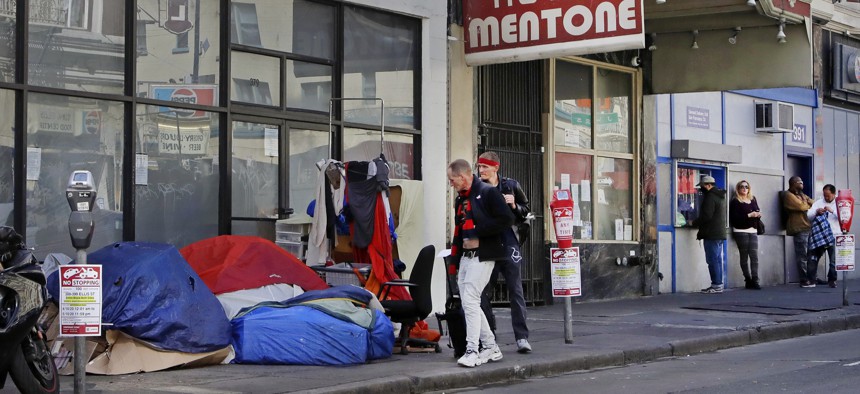Higher Rents Associated with Increase in Homelessness, Federal Watchdog Finds

In this Monday, April 13, 2020, file photo, pedestrians walk to the edge of the sidewalk to avoid stepping on people in tents and sleeping bags in the Tenderloin area of San Francisco. AP Photo/Ben Margot

Connecting state and local government leaders
The Government Accountability Office report comes amid concerns about evictions, as the coronavirus outbreak takes a financial toll on many Americans.
Even before the coronavirus pandemic hit, putting millions of people out of work, many Americans were struggling to afford the rising cost of housing.
A new federal watchdog report highlights the correlation between rising rents and homelessness in American cities—an increasing worry as the pandemic continues.
The Government Accountability Office report found that a $100 a month increase of the median rent price in a locality is associated with a 9% increase in homelessness.
The report analyzed the U.S. Department of Housing and Urban Development's homeless population count, which found nearly 568,000 people were homeless in 2019. While the report acknowledges that HUD’s count is likely an underestimate, it examines a number of factors that can influence changes in homelessness.
GAO researchers interviewed individuals who provide homeless services in 21 city and county governments about factors affecting homelessness and analyzed population and rent data from 2012 to 2018. In seven of the 11 jurisdictions where homelessness increased, the cost of housing was considered a primary factor in the increase in homelessness, according to the report.

“The U.S. is one of the richest, wealthiest, countries in the world, and it is shameful that so many across the nation, including in my city of Los Angeles, are living on the streets,” said U.S. Rep. Maxine Waters, the chairwoman of the House Committee on Financial Services who requested the GAO report. “The truth is that homelessness is a symptom of bigger problems, like America’s rental housing crisis, that for too long have gone unaddressed.”
Cities have struggled to create more affordable housing in recent years, with the U.S. short an estimated 7 million affordable and available rental homes for extremely low-income renters. Further, nearly 11 million renters spent more than 50% of their income on housing in 2018, according to a report from the Joint Center for Housing Studies of Harvard University.
Housing experts have warned that the coronavirus pandemic could put many renters in danger of becoming homeless as people who are out of work will be unable to pay their rent or mortgage.
State and local governments have enacted eviction moratoriums to protect tenants during the pandemic, but in areas where some have lapsed renters face an “eviction cliff.”
Marion County, Indiana saw 400 eviction cases filed in the time since the state’s moratorium expired on Friday. That’s more than double the average filings, according to local new station WIBC-TV.
Eviction filings also doubled in Cleveland, Ohio after a moratorium policy that took effect in March lapsed in June.
More than 800,000 Florida renters are at risk of evictions in the coming weeks as a ban on evictions is set to expire Aug. 31.
Andrea Noble is a staff correspondent with Route Fifty.

NEXT STORY: Saving in Times of Crisis: How People with Disabilities Can Increase Financial Stability




